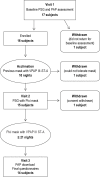Evaluation of a new pediatric positive airway pressure mask
- PMID: 25142768
- PMCID: PMC4153116
- DOI: 10.5664/jcsm.4030
Evaluation of a new pediatric positive airway pressure mask
Abstract
Study objectives: The choice and variety of pediatric masks for continuous positive airway pressure (CPAP) is limited in the US. Therefore, clinicians often prescribe modified adult masks. Until recently a mask for children aged < 7 years was not available. This study evaluated apnea-hypopnea index (AHI) equivalence and acceptability of a new pediatric CPAP mask for children aged 2-7 years (Pixi; ResMed Ltd, Sydney, Australia).
Methods: Patients aged 2-7 years were enrolled and underwent in-lab baseline polysomnography (PSG) using their previous mask, then used their previous mask and the VPAP III ST-A flow generator for ≥ 10 nights at home. Thereafter, patients switched to the Pixi mask for ≥ 2 nights before returning for a PSG during PAP therapy via the Pixi mask. Patients then used the Pixi mask at home for ≥ 21 nights. Patients and their parents/guardians returned to the clinic for follow-up and provided feedback on the Pixi mask versus their previous mask.
Results: AHI with the Pixi mask was 1.1 ± 1.5/h vs 2.6 ± 5.4/h with the previous mask (p = 0.3538). Parents rated the Pixi mask positively for: restfulness of the child's sleep, trouble in getting the child to sleep, and trouble in having the child stay asleep. The Pixi mask was also rated highly for leaving fewer or no marks on the upper lip and under the child's ears, and being easy to remove.
Conclusions: The Pixi mask is suitable for children aged 2-7 years and provides an alternative to other masks available for PAP therapy in this age group.
Keywords: children; patient interface; positive airway pressure; sleep disordered breathing.
© 2014 American Academy of Sleep Medicine.
Figures




References
-
- Chervin RD, Dillon JE, Bassetti C, Ganoczy DA, Pituch KJ. Symptoms of sleep disorders, inattention, and hyperactivity in children. Sleep. 1997;20:1185–92. - PubMed
-
- Gottlieb DJ, Vezina RM, Chase C, et al. Symptoms of sleep-disordered breathing in 5-year-old children are associated with sleepiness and problem behaviors. Pediatrics. 2003;112:870–7. - PubMed
-
- Marcus CL, Ward SL, Mallory GB, et al. Use of nasal continuous positive airway pressure as treatment of childhood obstructive sleep apnea. J Pediatr. 1995;127:88–94. - PubMed
Publication types
MeSH terms
LinkOut - more resources
Full Text Sources
Other Literature Sources
Research Materials
Miscellaneous

